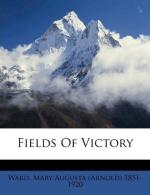The ten letters were written at intervals between February and May. It seemed better, in republishing them, not to attempt much recasting. They represent, mainly, the impressions of a journey, and of the conversations and reading to which it led. I have left them very much, therefore, in their original form, hoping that at least the freshness of “things seen” may atone somewhat for their many faults.
FIELDS OF VICTORY
CHAPTER I
FRANCE UNDER THE ARMISTICE
London, February, 1919.
A bewildering three weeks spent in a perpetually changing scene—changing, and yet, outside Paris, in its essential elements terribly the same—that is how my third journey to France, since the war began, appears to me as I look back upon it. My dear daughter-secretary and I have motored during January some nine hundred miles through the length and breadth of France, some of it in severe weather. We have spent some seven days on the British front, about the same on the French front, with a couple of nights at Metz, and a similar time at Strasburg, and rather more than a week in Paris. Little enough! But what a time of crowding and indelible impressions! Now, sitting in this quiet London house, I seem to be still bending forward in the motor-car, which became a sort of home to us, looking out, so intently that one’s eyes suffered, at the unrolling scene. I still see the grim desolation of the Ypres salient; the heaps of ugly wreck that men call Lens and Lieviny and Souchez; and that long line of Notre Dame de Lorette, with the Bois de Bouvigny to the west of it—where I stood among Canadian batteries just six weeks before the battle of Arras in 1917. The lamentable ruin of once beautiful Arras, the desolation of Douai, and the villages between it and Valenciennes, the wanton destruction of what was once the heart of Cambrai, and that grim scene of the broken bridge on the Cambrai—Bapaume road, over the Canal du Nord, where we got out on a sombre afternoon, to look and look again at a landscape that will be famous through the world for generations: they rise again, with the sharpness of no ordinary recollection, on the inward vision. So too Bourlon Wood, high and dark against the evening sky; the unspeakable desolation and ruin of the road thence to Bapaume; Bapaume itself, under the moon, its poor huddled heaps lit only, as we walked about it, by that strange, tranquil light from overhead, and the lamps of our standing motor-car; some dim shapes and sights emerging on the long and thrice-famous road from Bapaume to Albert, first, the dark mound of the Butte de Warlencourt, with three white crosses on its top, and once a mysterious light in a fragment of a ruined house, the only light I saw on the whole long downward stretch from Bapaume to Albert. Then the church of Albert, where the hanging Virgin used to be in 1917, hovering above a town that for all the damage done to it was then still a town of living men, and is now a place so desolate that one shrinks from one’s own voice in the solitude, and so wrecked that only the traffic directions here and there, writ large, seem to guide us through the shapeless heaps that once were streets. And, finally, the scanty lights of Amiens, marking the end of the first part of our journey.




